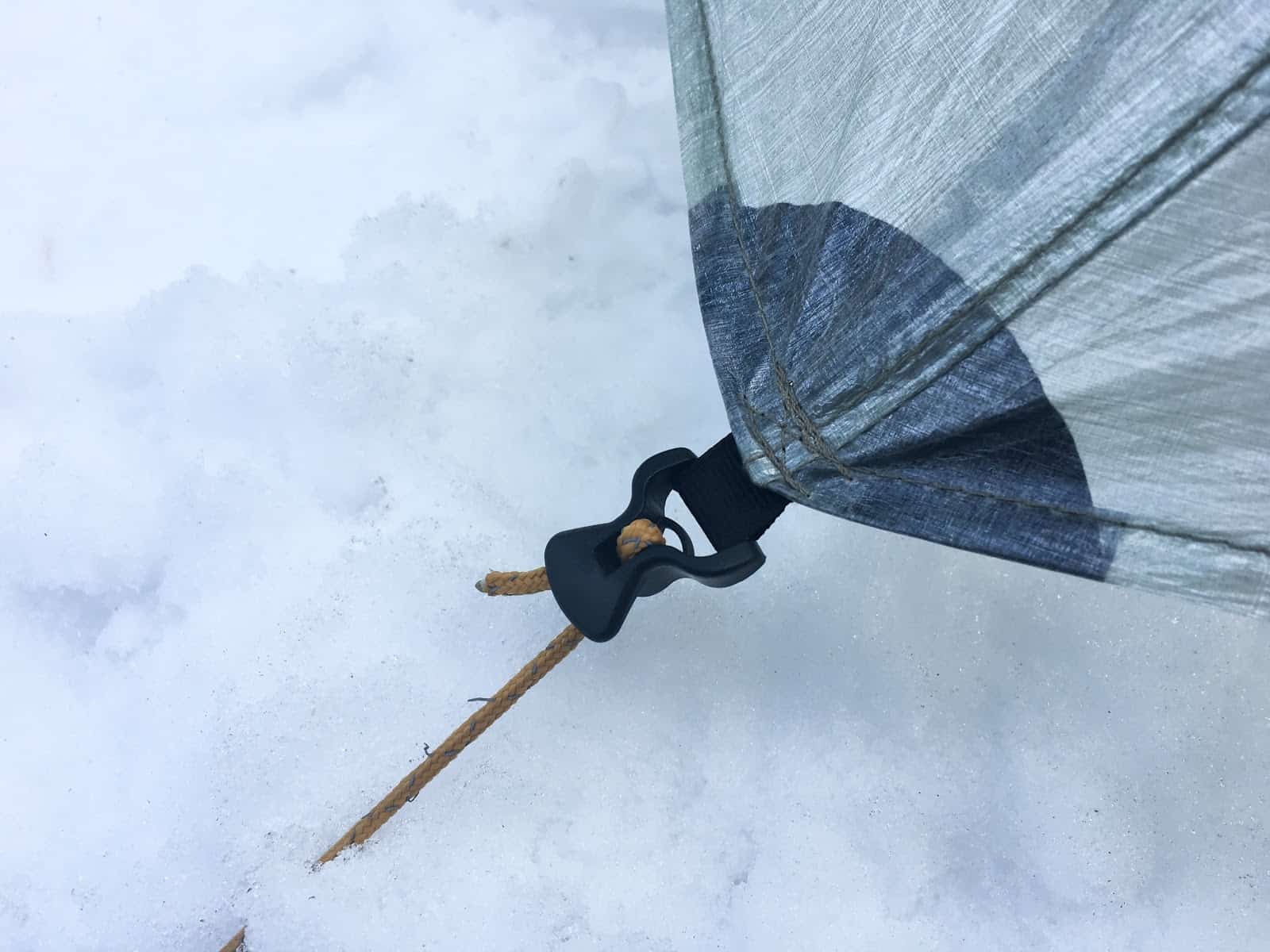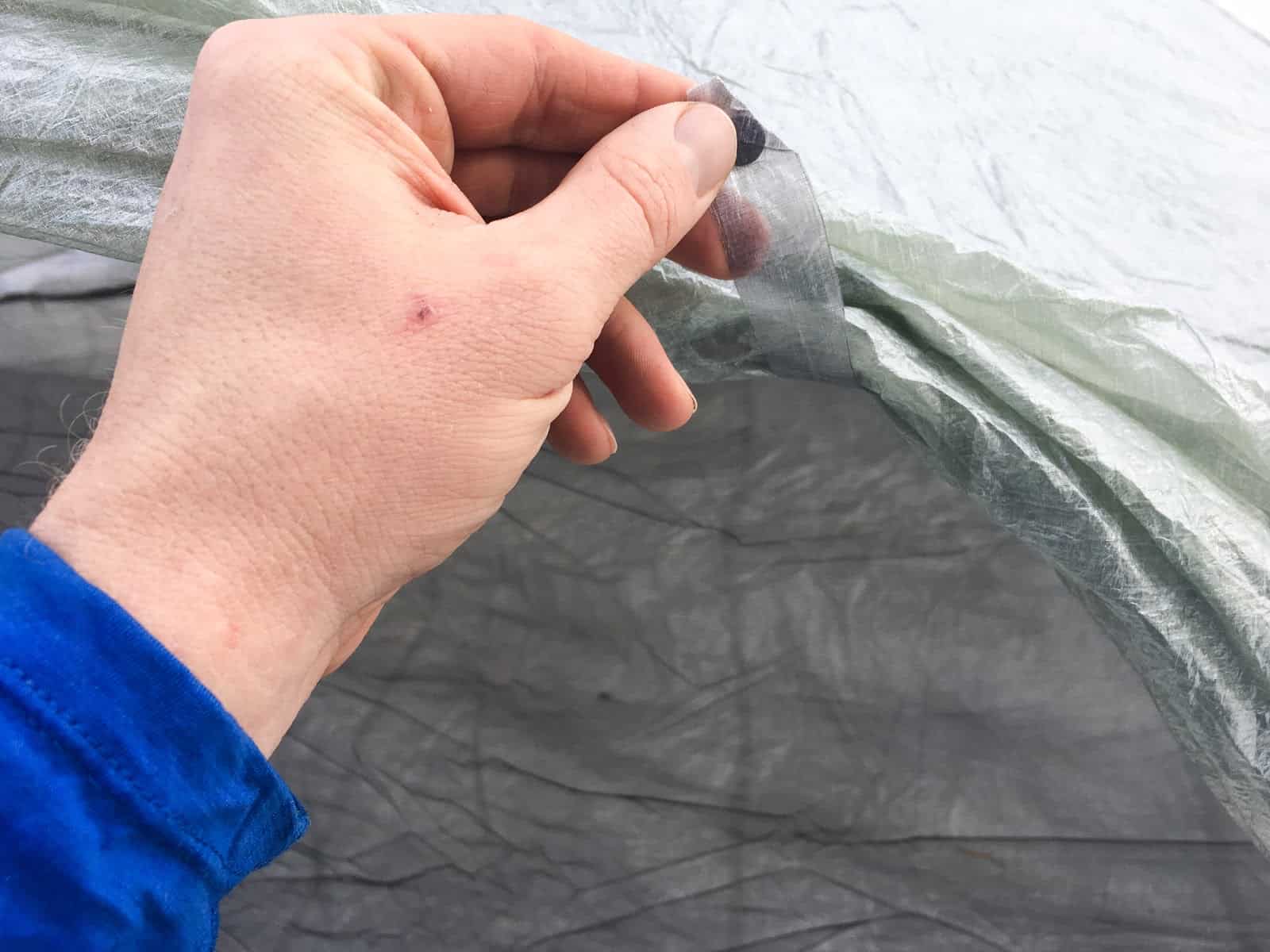Introduction

The Tarptent Stratospire Li is a roomy and stable two-person DCF shelter with well-considered features. It sets up quickly, stays taut in rough conditions due to DCF construction and Tarptent’s proprietary built-in tensioners, and has enough chops for year round use. I tested the Stratospire Li during an eight-day trek through Montana’s Absaroka-Beartooth Wilderness in the summer/fall shoulder season. Weather conditions were all over the map, meaning I had the opportunity to observe this shelter’s performance during clear (but cold) nights, light rain, mist, light snow, and driving wind.
Features and Specifications
Features
- Dyneema® fabrics: strong and light
- Seams are bonded and sewn
- Dual trekking pole set-up
- Double wall
- Dual vestibules are spacious and provide for dual entry
- Interior can be set up independently from the rest of the shelter
- Tarptent’s optional SideCar attachment turns either vestibule into a separate sleeping compartment for a pet or a kid (or both!)
- PitchLoc™ foldable corners and integrated line tighteners
- Reflective spectra cord guylines
- Catenary ridgelines
Specifications
- Sleeps: 2
- Seasons: 3+
- 8,000mm+ hydrostatic head pressure rating
- Manufacturer provided weight:
- 26 oz (738 g) tent body (fly, interior, guylines, carbon fiber struts, and stuff sacks)
- 1.7 oz (48 g) stakes
- Measured weight:
- 29.5 oz (836 g) tent body (fly, interior, guylines, carbon fiber struts, and stuff sacks)
- 1.7 oz (48g) stakes
- Fly: 0.51 oz (14.5 g) / yd² Dyneema
- Floor: 1 oz (28.3) / yd²
- Interior Height: 45 in (115 cm)
- Floor Width: 45 in (114 cm)
- Floor Length: 86 in (218 cm)
- Stakes: 6 x 6 in (15 cm) Easton Nanos (included)
- Packed size: 16 in x 5 in (41 cm x 12 cm)
Compared To
The Stratospire Li is most similar to the Zpacks Duplex: both are two-person DCF shelters designed to set up with trekking poles. An in-depth head-to-head performance review of the two is in order, but in the meantime, we can compare some of the basic features and specifications.

| Shelter | Zpacks Duplex | Tarptent Stratospire Li |
|---|---|---|
| Total weight | 19 oz (538.7 g) | 26 oz (737.1 g) |
| Tent body material | 0.51 oz (14.5 g) / yd² Dyneema | 0.51 oz (14.5 g) / yd² Dyneema |
| Floor material | Floor: 1 oz (28.3) / yd² | Floor: 1 oz (28.3) / yd² |
| Trekking pole position | Centered | Offset |
| Design | A-frame (six panels) | Octogonal (8 panels) |
| Vestibule | 2 | 2 |
| Doors | 2 | 2 |
| Independent interior | No | Yes |
| Interior Height | 48 in (121.9 g) | 45 in (114.3 cm) |
| Interior Width | 45 in (114.3 cm) | 45 in (114.3 cm) |
| Floor Length | 90 in (228.6 g) | 86 in (218.4 cm) |
| Stakes | 8 required (0 included) | 6 required, 2 optional, ( 6 included) |
| Cost | $599.00 | $679.00 |
The Duplex is a few inches longer and taller (interior) than the Stratospire Li. It features an A-frame six-panel design and weighs 19 oz (538.7 g). The Stratospire Li features an octogonal eight-panel design and is about $80.00 more expensive than the Duplex. It weighs 26 oz (737.1 g). The fly can set up independently from the interior. Both shelters are constructed of identical weight Dyneema Composite Fabrics and measure 45 in (114.3 cm) across the bottom of the floor.
Strengths and Limitations
Strengths
- Dyneema fabric resists condensation and will not absorb moisture, sag, or stretch
- Double wall design means any condensation that does occur won’t touch your stuff
- Octogonal design holds up extremely well in high winds
- Spacious vestibules
- Double door design is easy to get in and out of
- Thoughtful features: magnetic snaps, zipper covers to reduce condensation drip, PitchLoc corners, and integrated line tighteners
- Lots of optional features: solid wall design for four-season use, side-car attachment, trekking pole “handle up” set-up
Limitations
- Extremely high price tag ($679.00)
- Low stretch of DCF means you must exercise some precision in the pitch
- Shallow pitch angle could be a problem with serious snow loads
- Small interior gear pockets
- Feels bulky in a pack
Commentary

This is a roomy, tough, well-designed shelter. Tarptent rightly lauds the Stratospire Li’s performance in windy conditions.. The eight-panel design minimized noise and flap on a long, cold, windy night high in the Beartooths. The ridgeline remained tight (with the aid of the two optional stakes and tie-outs), and the integrated line tighteners were taut after ten hours of high-speed gusts. In short, Montana threw quite a lot of wind at this shelter, and it didn’t budge. I was camping with a group of ten hikers, and I was one of the few who passed an uneventful and cozy night.

The floor of the Stratospire Li is rectangular, but the fly is octagonal, and the trekking poles are offset. This can require a bit of thinking during setup, particularly if you are in a tight situation or your spot isn’t optimal. DCF fabric has very little stretch, meaning your stake angles and placement need to be a bit more precise than with a silnylon shelter. Make sure to watch Tarptent’s setup video. After viewing that and pitching the shelter a few times in a yard, I had no problem getting the shelter pitched in under two minutes.


The shelter sets up with trekking poles in a handle-down configuration (although Tarptent sells an adaptor to allow the handles to face up). I’ve used a silnylon Tarptent for years and never worried about poking a hole in my shelter with the carbide tip of the trekking pole, but something about the nearly seven-hundred dollar price tag of the Stratospire Li gave me pause every time I set it up. The good news is, should you happen to (carelessly) puncture the Stratospire Li, the DCF construction makes it much easier to patch than silnylon.

The shelter is roomy, with a 45 in (114.3 cm) wide and 86 in (218.4 cm) long bathtub floor. The apex height is 45 in (114.3 cm) tall. This space accommodates two standard sized sleeping mats with ease (or one standard mat and one wide mat with slightly less ease). There’s plenty of room to sit up and change clothes, even for tall hikers. Two doors and two vestibules make sharing the shelter as comfy as it gets, as well as optimizing airflow and views for those dramatic campsite days.

The vestibules are gigantic, more than large enough to accommodate cooking, wet gear, packs, dogs, or children. Tarptent sells an attachment to turn this vast space into a separate compartment should you be traveling with a child.
One side effect of these large vestibules is that the edge of the fly is quite far from the bathtub flooring after zipping the doors. The distance eliminates the “up-splash” problem (in heavy rain, water can splash up from the puddle created by the fly) occasionally experienced by smaller Tarptents.

Tarptent loaded the Stratospire Li with thoughtful features: floor and apex adjustment straps, storm sealed zippers, zipper flaps for drip protection, and magnetic closure loops to roll the outer fly up and out of the way.

The zipper flap also snaps up out of the way with a magnet. Remember to do this before unzipping, or you will have a stuck zipper.

I love this magnet system, and I wish it was also on the interior mesh door. Instead, that door rolls up with a clip and loop system, something I occasionally found challenging to manipulate with cold or gloved hands.



The Stratospire Li is a bulky tent when rolled and stored. The carbon fiber struts in the PitchLoc corners are removable if you feel like stuffing, but Tarptent recommends rolling to improve the lifespan of the DCF. I found the stuff sack to be large enough that rolling was not much of a pain, particularly if you follow the manufacturer instructions. That being said, the tent did feel chunky in my pack and required that I re-think my regular pack organizational system.
The interior pockets at the corners of the mesh doors felt small. Bulky, light items such as a Buff or stuff sacks tended to fall out throughout the night. Storing smaller, heavier items like a headlamp or a pocket knife are the ideal use for these pockets.
Tarptent sells an optional solid wall interior for extremely cold or windy conditions. Adding a solid wall interior would beef up an already storm-resistant tent, and give it some four-season potential. However, I’d be concerned that the Stratospire Li’s shallow pitch angle could give it some problems with heavy snow loads, though the DCF will not stretch under load and will shed snow better than silnylon.
Further testing is required, particularly to see how the tent fares in winter conditions, and in comparison to the Zpacks Duplex. Until then, this is a well-designed, well-constructed, thoughtfully realized shelter with enough toughness to withstand a wide range of seasons and conditions. Large, cozy, and stable while remaining ultralight, it won’t let you down—assuming you can stomach the price tag.

Where to Buy
Related Content
- The BPL community is discussing the Stratospire Li as compared to the Zpacks Duplex. Check out the convo here.
- Going solo or want something a little smaller? Ryan Jordan’s in-depth write up of the Tarptent Notch Li is worth a read.
Product Review Disclosure
Updated September 15, 2018
- How we acquired these products: Product(s) discussed in this review were either acquired by the author from a retailer or otherwise provided by the manufacturer at a discount/donation with no obligation to provide media coverage or a product review to the manufacturer(s).
- We do not accept money or in-kind compensation for guaranteed media coverage: Backpacking Light does not accept compensation or donated product in exchange for guaranteed media placement or product review coverage.
- Affiliate links: Some (but not all) of the links in this review may be “affiliate” links, which means if you click on a link to one of our affiliate partners (usually a retailer site), and subsequently make a purchase with that retailer, we receive a small commission. This helps us fund our editorial projects, podcasts, instructional webinars, and more, and we appreciate it a lot! Thank you for supporting Backpacking Light!



Home › Forums › Tarptent Stratospire Li Review